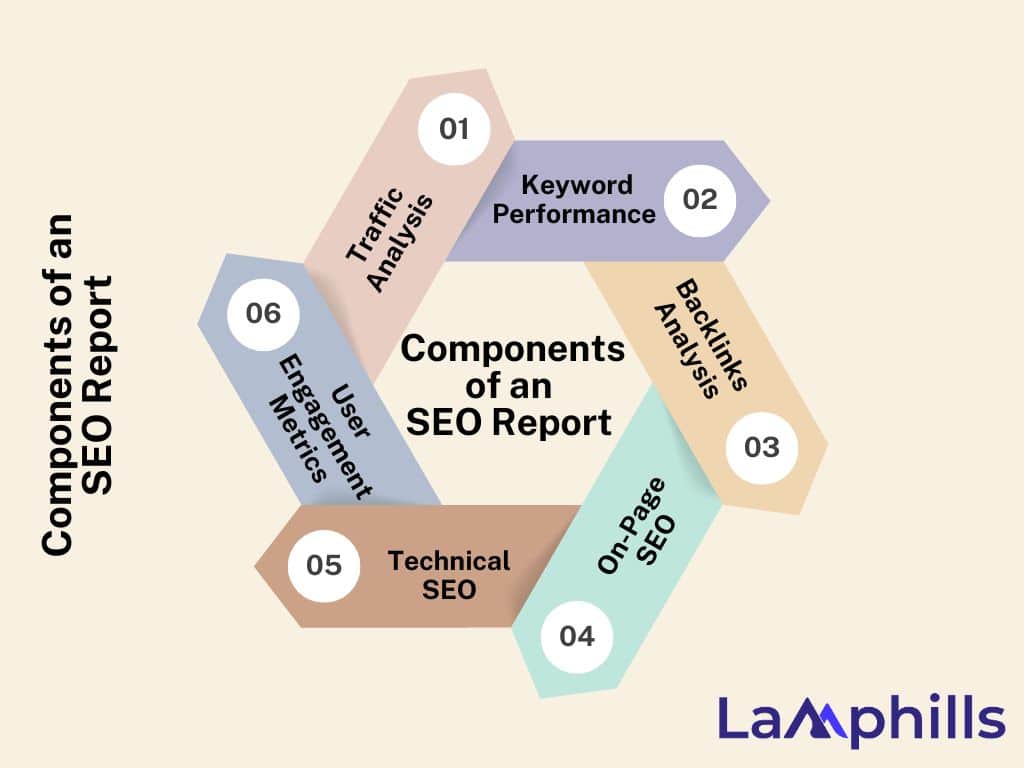Have you ever wondered what drives successful digital strategies in today’s competitive online space? It’s strategic search engine optimization. However, being strategic is insufficient; you must measure your campaign effectiveness with analytics and reports. A comprehensive SEO report helps you understand how well your website is doing and where you can improve. It reveals user behavior and optimizes content while propelling businesses forward in this digital era.
I’ve learned that harnessing the power of SEO isn’t solely about implementing strategies; it’s about decoding the metrics that define success. Today, I’ll share my process for creating detailed SEO reports, the best practices I follow, and useful templates to simplify crafting a comprehensive SEO report that illuminates your website’s performance. This will empower you to make informed decisions that drive real results.
Key Points
- An SEO report is a comprehensive document that provides an in-depth analysis of a website’s performance in terms of search engine optimization.
- It tracks various metrics and data points to evaluate a website’s performance in search engine rankings and how effectively it attracts and engages organic traffic.
- The time it takes to create an SEO report depends on the website’s complexities, the depth of the analysis required, the tools being used, and the level of detail expected in the report.
- Reviewing your SEO reports regularly enhances your online presence and helps you achieve better search engine rankings.
- A comprehensive SEO report will include an executive summary, traffic analysis, keyword performance, backlink analysis, on-page SEO, technical SEO, user engagement metrics, conversions, competitor analysis, visualizations and graphs, recommendations, and action plans.
Understanding SEO Report
You only report after assessing or analyzing a course, this principle also applies to SEO. Businesses that intend to increase their search engine rank adopt several strategies to boost their organic search. Strategies must be measured and presented as reports to avoid wasting time and resources. Therefore, SEO reports assess and analyze your website’s performance. It gives you a breakdown of things that work and don’t based on your marketing efforts. The report enables stakeholders to make informed decisions for better growth. What exactly do you find in a comprehensive SEO report? What are the components of this assessment? We’ll soon find out!
What is a Search Engine Optimization Report?
An SEO report is a comprehensive document that provides an in-depth analysis of a website’s performance in terms of search engine optimization. This report tracks various metrics and data points to evaluate a website’s performance in search engine rankings and how effectively it attracts and engages organic traffic. SEO reports offer insights that can help optimize and improve a website’s visibility, traffic, and overall online presence.
Components of an SEO Report

A comprehensive SEO report should cover several key components that reveal your website’s SEO health. The following are the components I used to gauge the overall SEO health of a website:
#1. Traffic Analysis
Under traffic analysis, I measure traffic sources. Traffic sources reveal where the visitors are coming from. I use Google Analytics to categorize traffic into organic, paid, direct, referral, and social. I also compare the organic and paid traffic received to uncover the best strategy. Generally, this helps me understand the effectiveness of my SEO efforts relative to my paid campaigns.
#2. Keyword Performance
Under keyword performance, I look for keywords ranked, keyword movements, search volume, and competition. With keyword rank, I identify keywords that are currently ranking. Under keyword movements, I track changes in keyword rankings over time to uncover whether keywords have improved or dropped in rankings. Lastly, I use search volume and competition to analyze the search volume and keyword competition level to understand their potential impact. In all sincerity, this is hard work; however, tools like Ahrefs or SEMrush simplify things.
#3. Backlink Analysis
Under backlink analysis, I assess the total number of backlinks, quality, and referring domains. The first provides the total number of backlinks pointing to my site, and the second focuses on the quality of backlinks rather than the quantity. It also highlights links from high-authority domains. Lastly, referring domains list the domains that are linking to your site. This reveals the health status of your backlink profile and identifies potential link-building opportunities. I use tools like Moz or Ahrefs to gather these reports.
#4. On-Page SEO
No SEO practice is complete without on-page optimization. Here, my focus is on page titles and meta descriptions, header tags, and content quality. I review page titles and meta descriptions for primary keywords. Head tags ensure proper use of header tags (H1, H2, and H3) to structure content and improve readability. On the other hand, content quality assesses the quality of my content to see if it’s informative, engaging, and includes relevant keywords naturally.
#5. Technical SEO
Technical SEO aims to improve a website’s visibility and SEO performance by being strategic about the architecture and backend activities of the website. To assess technical SEO, measure the site speed, mobile friendliness, and crawl errors. For site speed, I use Google PageSpeed Insights to analyze the site’s loading speed and provide recommendations for improvement. For mobile-friendliness, I use Google’s Mobile-Friendly Test tool. Lastly, I used the Google Search Console to identify and fix crawl errors. Generally, this ensures that search engines properly index the site.
#6. User Engagement Metrics
User engagement metrics indicate how visitors interact with your website. In essence, these metrics help you understand the quality of the user experience and the effectiveness of your content. Monitoring and analyzing these metrics reveal how users interact with your site. It also identifies areas for improvement and makes data-driven decisions to enhance the user experience and engagement. The following are the metrics I track under this:
- Bounce Rate: Generally, bounce rate tracks the percentage of visitors who leave your site after viewing only one page. As much as you can, reduce this number to the barest minimum because a high bounce rate indicates issues with user experience or content relevance.
- Average Session Duration: This measures how long visitors stay on your site. Generally, longer session durations indicate engaging content.
- Pages per Session: This analyzes the average number of pages viewed per session to understand user navigation and content engagement.
Others Include
- Click-Through Rate (CTR)
- Conversion Rate
- Returning Visitors
- Engagement Rate
Read Also: Ultimate Guide To SEO Reporting Software +Top 10 Free Tools for 2024
Tools and Software for SEO Reporting
To create a comprehensive SEO report, you need the right tools. The following are some of the ones I used:
- Google Analytics: Google Analytics provides detailed insights into your website traffic, user behavior, and conversions.
- Ahrefs: Ahrefs is excellent for keyword research, backlink analysis, and rankings.
- SEMrush: SEMrush offers various SEO tools, including keyword research, site audits, and competitive analysis. It also identifies opportunities and tracks performance.
- Moz: Moz is known for its user-friendly interface and powerful SEO tools. It helps with keyword research, link building, and on-page optimization.
- Google Search Console: Google Search Console is essential for monitoring your website’s presence in Google search results. It helps identify issues and provides insights into your site’s performance.
Step-by-Step Guide to Creating an SEO Report
Want to create a comprehensive SEO report with ease? The following steps will be of great help to you:
#1. Setting Objectives
Before diving into the data, define the goals of your SEO efforts. Align these goals with your overall business objectives to ensure your report is focused and relevant.
#2. Set Your Key Performance Indicators (KPIs)
After clarifying the objective of your report, determine the key performance indicators (KPIs) for measuring your SEO strategies. The specific metrics you choose will depend on your business’s objectives and priorities. KPIs are the main metrics that matter most to you. These metrics best indicate whether you’re achieving your goals or not. Depending on what your business goals are, the following are some common KPIs to measure:
- Website Traffic: Measure the overall number of visitors to your site. This gives you a broad view of your site’s reach and popularity.
- Page Load Speed: Track how quickly your pages load. Generally, faster load times increase user experience and can positively impact your SEO rankings.
- Backlinks: Count the number and quality of backlinks pointing to your site. High-quality backlinks are a strong signal of authority and trustworthiness in SEO.
- Conversions: Monitor the number of visitors who complete desired actions on your site. This might be purchasing an item, filling out a form, or signing up for a newsletter. This metric directly ties your SEO efforts to business outcomes.
#3. Data Collection
Use the relevant tools to gather data from your chosen KPIs. Be careful when collecting data and ensure it’s accurate and consistent by cross-referencing multiple sources. You’ll have to analyze this data, and conflicting data affects the overall report.
#4. Data Analysis
Analyze the collected data to identify trends, patterns, and areas of improvement. Look for significant changes in traffic, keyword rankings, and backlink profiles. All these will be used to create a professional report.
#5. Reporting Format
Choose a format that suits your audience and purpose. Although PDF, Excel, and Google Sheets are popular choices, choose what works for you. Ensure the report is well-structured and readable regardless of the format used.
#6. Visualizing Data
If you’re an SEO specialist, chances are your client doesn’t understand the metrics used to gauge your report. You’ll have to clarify things by summarizing the report using visuals. You can use charts, graphs, and tables to visualize the data. This makes it easier to understand complex information and highlights key insights.
#7. Summarize and Make Recommendations
Looking at your visual presentation, anyone who understands how SEO works will be able to summarize the report. However, you’re expected to summarize your report using simple sentences. That way, your clients will understand it easily. Provide specific, actionable recommendations based on your analysis. Lastly, prioritize tasks based on their potential impact on SEO performance.
Read Also: Free vs. Paid SEO Reporting Software: Which One is Right for You?
Best Practices for Writing a Comprehensive SEO Report
We’ve considered the steps and relevant tools needed to write a compelling SEO report, let’s take a look at some of the best practices too:
#1. Regular Reporting
Determine the frequency of your reports based on your needs. Frequency here is how often you’ll be analyzing your report. It can be weekly, monthly, or quarterly. I prefer the monthly report because it helps me track progress and make timely adjustments.
#2. Tailor Reports to Your Audience
I do customize my reports for different stakeholders. Why? Some executives prefer high-level summaries, while marketing teams need detailed analysis and actionable insights. If this applies to you, then tailor the reports to meet the needs of the end users.
#3. Ensuring Transparency and Accuracy
Provide clear and honest insights. Avoid data manipulation and present findings accurately to build trust with your audience.
#4. Using Comparative Analysis
I love positive results and progress. That’s why I compare current performance with past periods. With that, I’ve been able to identify trends and measure progress. Secondly, I benchmark against competitors to understand my position in the industry.
#5. Stay Up-to-Date
Keep abreast of the latest SEO trends and updates. With technological advancement, more tools and methods keep popping up, and you need to incorporate these insights into your reports. That’s the only way to stay relevant and effective.
Read Also: My SEO Workflow: A Comprehensive Guide to Boosting Your Search Rankings
Lamphills SEO Report Template
This Ahrefs template covers all components discussed in this article. It provides in-depth analysis and recommendations, making it suitable for detailed performance reviews.
Download Lamphills SEO Report Template
What Does an SEO Report Include?
A comprehensive SEO report includes the following:
- Executive Summary
- Traffic Analysis
- Keyword Performance
- Backlink Analysis
- On-Page SEO
- Technical SEO
- User Engagement Metrics
- Conversions
- Competitor Analysis
- Recommendations and Action Plan
- Visualizations and Graphs
How Long Does an SEO Report Take?
This depends on the complexity of the website, the depth of the analysis required, the tools being used, and the level of detail expected in the report.
SEO Report Generator
An SEO report generator is a tool or software designed to compile and present data on a website’s search engine optimization (SEO) performance. It collects information from various SEO metrics and sources, such as website traffic, keyword rankings, backlink profiles, and technical SEO aspects, and organizes it into a comprehensive report. This report helps website owners, marketers, and SEO professionals understand the current state of their SEO efforts, identify areas for improvement, and track progress over time. SEO report generators save time and effort by automating the reporting process and presenting complex data in a clear, actionable format.
Features of SEO Report Generator
The following are some of the features of an SEO report generator:
- Automated Data Collection
- Traffic Analysis
- Keyword Performance
- Backlink Analysis
- Technical SEO Metrics
- Competitor Analysis
- Visualizations
- Actionable Insights
Conclusion
An SEO report is an overview of a website’s SEO performance. With this, businesses can understand where they stand, what’s working, and where improvements are needed. That’s why it’s important to review this regularly. Regular SEO reports enhance your online presence and help you achieve better search engine rankings. The practices and strategies I outlined above will help you create a detailed, accurate, and actionable comprehensive SEO report.
Related Articles
- Link Spam: Types, How I Identify and Avoid Them in 2024
- Understanding LinkedIn SSI Score: What It Is and How You Can Improve It
- What Are Resource Pages? Link Building, Examples, and How to Create One (+Templates)






